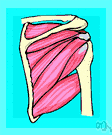Dysphagia, cranial dysmorphism, extremity anomalies, hypoplasia of the
pectoralis minor muscle (Poland anomaly) and mental deficiency may also be observed in association (1).
Using a blunt dissection, a subpectoral pocket was developed, without affecting
pectoralis minor muscle. Once a satisfactory subpectoral pocket was created, the generator unit was placed in it (Figure 7A), and then the muscle was primarily closed over the device.
The pectoral fascia was dissected and the pectoralis major was cut at its humeral insertion, permitting identification of the clavipectoral fascia immediately above the
pectoralis minor muscle. Sectioning exposed the infraclavicular neurovascular structures, including the transition between the subclavian and axillary vessels and the brachial plexus fascicles, as well as the distribution of its terminal branches in the axillary fossa and medial bicipital groove of the arm (Fig.
Serial helical scans of upper chest revealed that there was complete absence of both sternal and clavicular parts of right pectoralis major and
pectoralis minor muscle. This was associated with hypolastic, thinned anterior second to fourth ribs.
The pectoralis major muscle was under-developed but the
pectoralis minor muscle as well as the anterior serratus muscle were present (Figure-2).
Near the lateral margins of the
pectoralis minor muscle, each cord terminates in 2 major nerve branches (Figure 1).
(4) Despite the fact that thoracic outlet syndrome has been reported as a clinical entity for 65 years it is only in the last decade that the involvement of the
pectoralis minor muscle, in some form, has been noted in over 50% of patients with a diagnosis of TOS, even if the primary site of entrapment is not in the subcoracoid space.
A relationship between
pectoralis minor muscle tightness and rounded shoulder posture (RSP) has been suggested, but evidence demonstrating that treatment aimed at the pectoralis minor affects posture or muscle function such as lower trapezius strength (LTS) remains lacking.
He was treated with physical therapy for a torn
pectoralis minor muscle that was thought to have caused the thrombosis, and postural correction.
To the
pectoralis minor muscle, to be precise, which, the Manhattan-based doctor says, is the culprit that pulls the breast down.
Patricia Wexler has extended the range of Botox injections from the face to the breast--or more precisely, to the
pectoralis minor muscle, the culprit that pulls the breast down, the Manhattan-based doctor explains.
 musculus pectoralis minor - a skeletal muscle that draws down the scapula or raises the ribs
musculus pectoralis minor - a skeletal muscle that draws down the scapula or raises the ribs